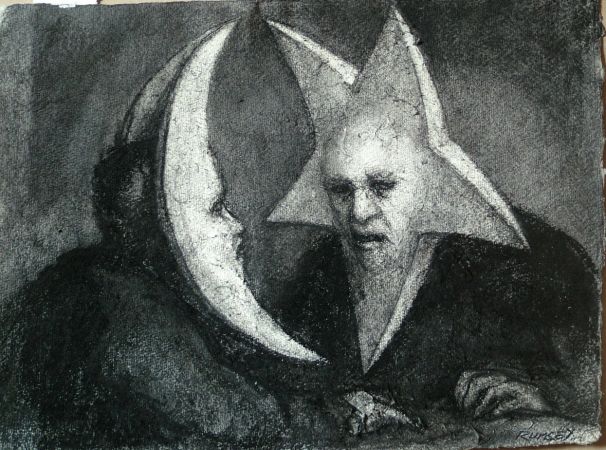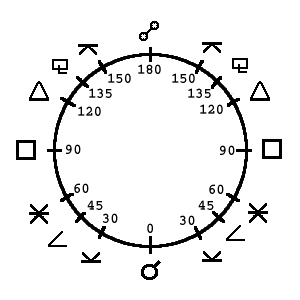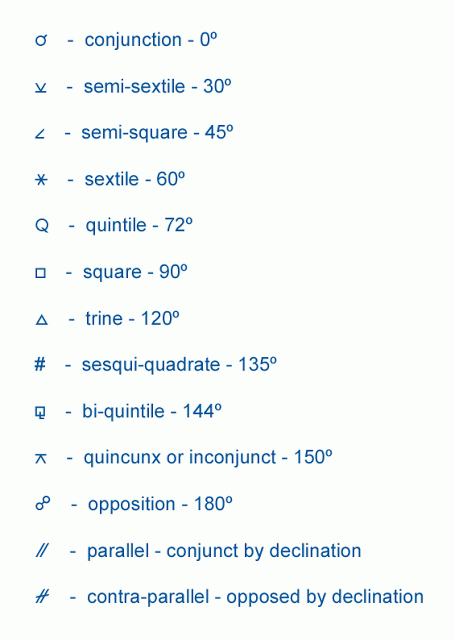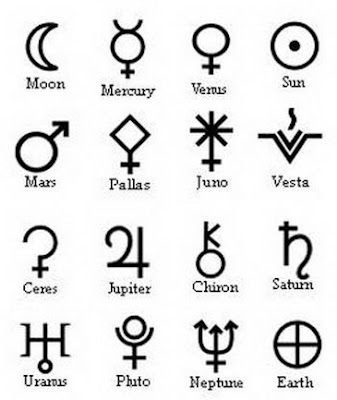
04 Feb THE PLANETS OF OUR SOLAR SYSTEM & SACRED GEOMETRY
Aspects
Now I will define the aspects, which are the geometrical relationships between planets which indicate how the corresponding archetypes tend to interact with each other and express themselves in one’s life.
An aspect is a specific angular relationship (such as 90 degrees or 180) between two planets. The existence of an aspect between planets indicates a mutual activation of the corresponding archetypes. That is, when two planets are positioned in a specific angular relationship (measured in degrees of celestial longitude along the ecliptic), the two corresponding planetary archetypes are brought into interaction and into concrete expression in human affairs. (For example, if Mercury and Pluto are in close aspect in one’s birth chart, then a decisive interaction between the Mercury and Pluto archetypes would tend to be visible in one’s life and character.)
There are five major aspects:
conjunction (approx. 0 degrees between planets)
opposition (approx. 180)
trine (approx. 120)
square (approx. 90)
sextile (approx. 60)
Of the major aspects, the conjunction and opposition are the most significant and potent, representing the two climaxes of any planetary cycle (for example, the new Moon and full Moon, which are formed by the Moon’s conjunction and opposition with the Sun). The trine and square aspects are intermediate in strength, the sextile the least potent. Also, generally speaking, the more exact the aspect (for example, two planets that are 2 degrees away from exact conjunction, rather than 7 degrees), then the more pronounced will be the archetypal interaction.
The trine and sextile generally indicate a harmonious (“soft”) interaction between two planetary archetypes, in which the two principles or forms of energy tend to flow together in an easy manner. The opposition and square correspond to a more dynamic or conflicting (“hard”) interaction. Here the two principles tend to have a more dialectical relationship, working both with and against each other; the individual has to work hard to bring the two together in a positive way, to have them come to terms with each other. And the conjunction indicates a synthesis in which the interaction can be of either category. Thus an aspect between two planets brings the two corresponding archetypes into interaction, and also determines the nature of that interaction.
[For those who are interested in these matters, the character of each aspect is defined by Pythagorean principles. The major aspects are formed by dividing the 360 degree circle by the whole numbers 1, 2, 3, 4, and 6, respectively, and the Pythagorean meaning of each number gives to the corresponding aspect its specific quality. Thus the unity or synthesis inherent in the number 1 and the conjunction; the polarity or duality inherent in the number 2 and the opposition; the equilibrium or stable balance of the number 3 and the trine. The characters of the square (4) and the sextile (6) derive from their components (2×2 and 3×2), with the square resembling the opposition, and the sextile resembling the trine.]
Also important in our analysis are alignments known as midpoints, which can be regarded as a more subtle kind of aspect. When one planet is positioned in aspect to the exact midpoint of two other planets, then the corresponding archetypes are considered to be brought into interaction. Such a configuration indicates a complex mutual activation of all three archetypes.
Although by necessity we discuss the various individual aspects and midpoint configurations in a chart in isolation, two or three planets at a time, in actuality they are all parts of an integrated whole that is greater than the sum of its discrete parts. This complexly interacting whole, one’s birth chart, ultimately defies full intellectual comprehension, but by selecting out and focusing on the individual aspects and their specific archetypal dynamics, we can shed considerable light on the whole birth chart and the life it symbolically reflects.
Let me emphasize here that though the soft aspects are indeed great gifts, it is often the hard aspects, in both birth charts and transits, that prove to be the most fruitful in a person’s life, sometimes dramatically so. Although they are rightly associated with difficulties, crises, and challenges, it is the hard aspects that tend to make things happen in life. The pressure of their conflict tends to create greater energetic dynamism, and challenge one to move toward higher creative syntheses. They are more likely to produce concrete manifestations, strengthening of character, deepening of the soul. Also, as one works through the negative side of such an aspect, the psychic energy that is bound within that archetypal complex can be freed up to manifest in more creative, life-enhancing ways (e.g., the compulsive rigidity that can accompany hard Saturn-Pluto aspects can turn into sustained strength of purpose, and so forth). Individuals who achieve things of real consequence in life regularly have birth charts with hard aspects between the planets most relevant to their achievement, and those major achievements often occur during periods of life marked by demanding transits.
Transits
The study of transits is especially valuable because it allows us to get a sense for the timing of the planetary archetypes in our lives. Perhaps of all areas of astrology, it is the study of transits that produces the most compelling evidence for the power of the astrological perspective, and its immense pragmatic value. The principle of transits rests on the fact that as the planets continue moving after a person’s birth, they move into and out of aspect in relation to the natal planetary positions. Thus when any planet’s present position in the sky forms an aspect to a point that was occupied by any planet at the time of one’s birth (for example Uranus now in the sky forming a conjunction to Venus in the natal chart), then during the period in which that particular aspect is in range one would tend to have experiences that correlate with the planets and aspect involved (in this example, a two-or-three year period in which one would tend to experience the awakening of new love, the stimulation of one’s artistic creativity or aesthetic responsiveness to life, a certain restlessness and unpredictability in one’s relationships, and so forth).
While the birth chart in itself is a portrait of one’s life and character as a whole, transits to the birth chart reflect the dynamic unfolding of one’s life and character in terms of specific events and experiences. Transits activate the potential that is inherent in the birth chart.
Since different planets move at different speeds, the duration of their transits varies–a Moon transit lasting only several hours, a Sun or Mars transit several days, and the outer planets several months or even years. The transits of the inner planets are useful for understanding the day-to-day changes and shorter cycles of one’s life, but it is transits from the four outermost planets–Saturn, Uranus, Neptune, and Pluto–that are of the greatest significance in understanding life’s larger dynamics.
There are a number of other significant factors in the birth chart that are well worth examining, such as the sign positions of the planets (Aries, Taurus, Gemini, etc.), the houses, the elements and qualities, hemispheric emphasis, harmonics, as well as other predictive techniques such as progressions, solar arc directions, solar and lunar returns, etc. I find all of these to be valuable factors to explore, and I may at times bring some of them into discussion, but my own particular expertise, as well as the bulk of my empirical research, is in the area of interpreting the combinations of planetary archetypes, the major aspects (including midpoints), and transits. I regard these, after many years of research, as the most essential factors in astrology, possessing great precision and richness of meaning. These factors reflect a certain beautifully lucid geometry of archetypal forms and forces, and I believe they offer the most intellectually cogent and clarifying path of entry into the mysteries of the astrological perspective.
I recommend seeking out interpretations or readings from every good astrologer who crosses your path, for astrology is so complex, and your chart has so many facets and levels of meaning, that each astrologer can illuminate it in new ways and give you important new insights. Also, my own focus is on the psychological and spiritual dimensions of life (as well as on long-term cultural and historical cycles). There are other astrologers who focus on medical, financial, horary, and other specialized areas of astrology, which you may find particularly relevant to your own interests. But beyond getting readings from good astrologers, I believe the most rewarding path to take in the end is to learn something about the field for yourself, learn how to calculate your own transits (it is not difficult), and then examine the evidence and experience this profound source of insight and understanding for yourself.
A few last comments
Every planetary combination has a problematic side as well as a more obviously beneficent and productive side, and I always attempt to describe both as clearly as possible. But particularly the hard aspects between planets (both in the birth chart and in transits) are likely to challenge one to come to terms with the energies involved, and in describing these one should not sugarcoat them so that it would seem as if you have only marvelous personal qualities and your life has been and will always be an uninterrupted series of wonderful experiences. No one’s life or character is like that. The birth chart provides a vivid portrait of one’s self, and its usefulness is dependent on how clearly and fully you are willing to face your true character, including parts of yourself and your life that may be difficult or hidden. An astrological chart provides a kind of x-ray of the soul and its movements, which cuts through the more superficial levels of the psyche to reach the archetypal foundations of one’s life and being.
The main thing to understand here is that astrology is not concretely predictive, but archetypally predictive. That is, the birth chart and transits indicate which universal principles are emphasized, in what combination, and when. They do not give information such as “You will get an offer of a job as editor-in-chief for a large publishing firm on April 26, 2004,” or “You will meet your soul mate on the beach at Waikiki at sunset on New Year’s Day in 2005.” It may not be impossible for a gifted clairvoyant to do something like this, but astrology has a different character.
Along the same lines, some archetypal dynamics symbolized in our birth chart we recognize as true, but not so much of our own character as of the kinds of experiences we have drawn towards us, the character of events and relationships that are in our life. This is because the archetypal patterns in our birth chart describe the quality of our life experience. One cannot know for sure whether the particular archetypal energies will be something one is conscious of in oneself, or whether they express themselves in the larger sphere of one’s life in the events, relationships, and circumstances that are to some degree external to one, yet ultimately reflect one’s own consciousness. Particularly if we have not psychologically “owned” those qualities in our chart, we will tend to project them onto others–and thus draw towards us others who will fulfill those energies in our life. As Jung often said, what is forced to remain unconscious comes to us as “fate.”
The value of a good astrological analysis is that it can shed a more coherent light on the many diverse and often chaotic particulars of our life, so that we can see clarifying archetypal patterns in it. In terms of the more problematic qualities suggested in the chart, some of these will no longer seem relevant to us simply because we have already lived them through, fully experienced their challenges, and outgrown them. More than that, we will have integrated those aspects and made them work for us in a more positive way. And that of course is as it should be. An analysis like this is meant to further encourage just this process. As an ancient esoteric dictum put it: “The sagacious person enhances the workings of the heavens in the same way a farmer enhances the workings of nature.”
Finally, it is important to realize that, at least in one crucial sense, astrology operates beyond good and evil. All archetypes are Janus-faced, with positive and negative sides, and as the foregoing discussion suggests, no astrologer can look at a chart and, simply on that basis, conclude whether that person is “good” or “bad.” The birth chart does not determine the moral vector of personal character. Nor does it determine ultimate “success” or “failure.” It portrays rather the basic nature of the archetypal dynamics that inform that individual’s life and character. How the individual copes with and grows through those particular dynamics, how she or he creatively embodies and integrates the diverse potentials of the birth chart, depends in the last analysis on the individual. The same archetype can express itself benignly or destructively, in an exalted way or an ignoble way, and to a great extent which of these occurs will be affected by the kind of consciousness that is brought to the situation. The god needs to be honored, the archetype will manifest, but there is considerable latitude as to how that may happen.
And herein lies the importance of astrological insight, for the very act of knowing the nature of the particular archetypes that are seeking to manifest, combined with an awareness of their potential timing, can play a significant role in positively influencing the outcome. Then life becomes more of a dance–a subtle interaction between archetypal forces and human awareness, a play of consciousness between the gods and the human mind and will and heart which they inform.
TITLE IMAGE: PAUL RUMSEY, ASTROLOGERS
IMAGES VIA: http://etherealcounterparts.blogspot.ca/2011/09/astrological-symbols.html







No Comments